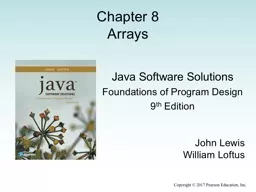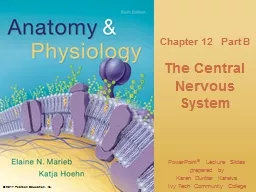PPT-© 2017 Pearson Education, Inc.
Author : tawny-fly | Published Date : 2018-01-09
Chapter 9 The Sun 2017 Pearson Education Inc Units of Chapter 9 The Sun in Bulk The Solar Interior The Solar Atmosphere The Active Sun The Heart of the Sun Summary
Presentation Embed Code
Download Presentation
Download Presentation The PPT/PDF document "© 2017 Pearson Education, Inc." is the property of its rightful owner. Permission is granted to download and print the materials on this website for personal, non-commercial use only, and to display it on your personal computer provided you do not modify the materials and that you retain all copyright notices contained in the materials. By downloading content from our website, you accept the terms of this agreement.
© 2017 Pearson Education, Inc.: Transcript
Chapter 9 The Sun 2017 Pearson Education Inc Units of Chapter 9 The Sun in Bulk The Solar Interior The Solar Atmosphere The Active Sun The Heart of the Sun Summary of Chapter 9 2017 Pearson Education Inc. Chapter 8 Moons, Rings, and Plutoids. © 2017 Pearson Education, Inc.. Units of Chapter 8. The Galilean Moons of Jupiter. The Large Moons of Saturn and Neptune. The Medium-Sized Jovian Moons. Planetary Rings. Chapter 17 Cosmology. © 2017 Pearson Education, Inc.. Units of Chapter 17. The Universe on the Largest Scales. The Expanding Universe. Cosmic Dynamics and the Geometry of Space. The Fate of the Cosmos. Question 1. Based on their shapes and stars, elliptical galaxies are most like the Milky Way’s. disk . and spiral arms.. halo. .. central . bulge.. open . clusters.. companion . galaxies,. the . Magellanic. Question 1. © 2017 Pearson Education, Inc.. Both Jupiter and Saturn. have liquid metallic . hydrogen in . their interiors.. have rings.. emit more energy than . they . absorb . from the Sun.. rotate very rapidly.. Question 1. Some regions of the Milky Way’s disk appear dark because. there . are no stars there.. stars . in that direction are obscured by interstellar . gas. .. stars . in that direction are obscured by . . Inc. .. Question 1. Constellations appear to move across the sky at night because the. Earth orbits the Sun.. Moon orbits the Earth.. stars are in constant motion.. Sun orbits the Earth.. Earth spins on its axis.. . Inc. .. Question 1. Which of the following are . terrestrial. planets?. Only Earth. Earth, Moon, and Venus. Mercury, Venus, Earth, and Mars. Mercury, Venus, Earth, Moon, Mars, and Pluto. Mercury, Venus, Earth, Moon, Mars, and Ceres. Chapter 6 The Terrestrial Planets. © 2017 Pearson Education, Inc.. Units of Chapter 6. Orbital and Physical Properties. Rotation Rates. Atmospheres. The Surface of Mercury. The Surface of Venus. The Surface of Mars. Question 1. The Drake equation attempts to define the number of. planets . in the Milky . Way Galaxy. .. planets . with life in . the universe. .. stars . with planets . like Earth. .. civilizations . Chapter 4 The Solar System. © 2017 Pearson Education, Inc.. Units of Chapter 4. An Inventory of the Solar System. Interplanetary Matter. Formation of the Solar System. Planets Beyond the Solar System. Chapter 9. Inheritance. Java Software Solutions. Foundations of Program Design. 9. th. . Edition. John Lewis. William Loftus. Inheritance. Inheritance is a fundamental object-oriented design technique used to create and organize reusable classes. Copyright © 2017 Pearson Education, Inc. Chapter 5 Conditionals and Loops Java Software Solutions Foundations of Program Design 9 th Edition John Lewis William Loftus Conditionals and Loops Now we will examine programming statements that allow us to: Copyright © 2017 Pearson Education, Inc. Chapter 8 Arrays Java Software Solutions Foundations of Program Design 9 th Edition John Lewis William Loftus Arrays Arrays are objects that help us organize large amounts of information , Inc.. 12.2 Cerebral Hemispheres (cont.). Cerebral White . Matter. Second of the three basic regions of cerebral hemispheres. Responsible for communication between cerebral areas, and between cortex and lower CNS .
Download Document
Here is the link to download the presentation.
"© 2017 Pearson Education, Inc."The content belongs to its owner. You may download and print it for personal use, without modification, and keep all copyright notices. By downloading, you agree to these terms.
Related Documents














